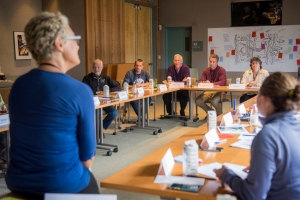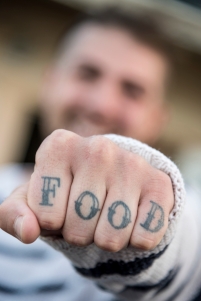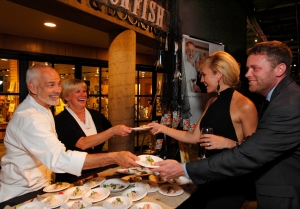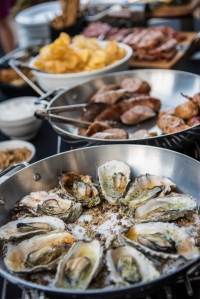Twenty food experts—chefs, culinary instructors, media and writers—gathered around a table, brainstorming about what it means to make an impact.

“Changing minds,” someone called out.
“Inspiring action,” said another.
The 20 are members of the Aquarium’s Blue Ribbon Task Force, a group of 63 culinarians who are actively promoting sustainable seafood nationwide. Each year, a subset of the Task Force meets in Monterey to learn, swap ideas with their peers, and get inspired.
Sheila Bowman, the Aquarium’s Manager of Culinary and Strategic Initiatives, runs the program. “Task Force members come from a variety of culinary fields. They include chefs, educators, food media and others,” she explains.
“What unites them is that they are all the kind of person who speaks out. Rather than just working in their kitchens or at their desks, they’re actually out in public and on social media, talking about sustainable seafood and doing something about it.”
The Task Force convened alongside the Aquarium’s Sustainable Foods Institute in mid-September.

Trusted Voices
The Task Force is closely tied to the Aquarium’s Seafood Watch program. Seafood Watch provides consumers and businesses with the information they need to choose seafood that’s been fished or farmed in environmentally responsible ways.
Task Force members are the secret ingredient for getting the word out to the public about sustainable seafood. They’re the folks who turn Seafood Watch’s science-based recommendations into action.
Chefs and other culinary experts do more than influence how restaurants source their seafood; they also create more demand for sustainable products. They do this by sharing their passion for food that is both delicious and sustainable.
That means opening people’s minds, and mouths, to new and under-utilized species from Seafood Watch’s “Best Choices” list. It means telling stories about the fish they serve and enjoy: what it is, where it came from, and how it was caught or farmed.
Blue Ribbon Task Force members communicate with customers and staff in their restaurants, and in print, on TV and online. Combined, the group has a social media audience of over 2 million people—so their views on sustainable seafood can make a big splash.

Passionfish, a restaurant in Pacific Grove (just down the road from the Aquarium), is one of the earliest Seafood Watch partners. Its owners, Cindy and Ted Walter, were asked to join the Blue Ribbon Task Force this year. But they’ve been committed to serving sustainable seafood since they started the business 20 years ago.
“My father was a commercial fisherman, and my mother was of Native American heritage,” Cindy says. “So I was taught as a child to take only what you need, and that it matters how you harvest it.”
At first, it was a bit tricky finding sustainable seafood sources. But after the first Seafood Watch recommendations came out in 1999, Cindy and others like her began to ask questions that created demand—and the market started to shift. Cindy and Ted blog about sustainable seafood to help spread the word.

Experiential learning
During the annual Blue Ribbon Task Force gathering, participants get first-hand experience with seafood production.
“Most people in the culinary field have been to a pig farm, an organic produce farm, a brewery, a winery and a chicken producer,” Sheila says. “But not many of them have been to a fish farm or a seaweed farm, or been out on a commercial fishing vessel.”
This year’s group had the opportunity to visit a seaweed farm just up the highway from the Aquarium, in Moss Landing. There, they met farm co-owner Michael Graham, who is also a professor and algae expert at California State University’s Moss Landing Marine Labs.
Michael told the task force members how the farm raises dulse, a thick, red seaweed known for its bacon-like texture when fried; ogo, another red seaweed that is excellent straight from the farm’s tanks; and sea lettuce, a tender green, leafy seaweed. The farm shares its seawater with a horde of baby abalone, which will be raised and harvested by a neighboring abalone farm.

Changing food culture
Seaweed can be ultra-sustainable aquaculture. If the nearby ocean water is naturally nutrient-rich, as it is in Monterey Bay, all you need to grow it is sunshine. But seaweed, and other less-familiar sustainable seafood products, are rare in the Western diet. How can the American public be convinced to eat them in restaurants, and cook with them at home?
That, Sheila says, is where Task Force chefs and culinarians come in. “When told that a dish is delicious and sustainable—and maybe even an adventurous new taste—most people will give it a try,” she says.
Using the power of the palate, Blue Ribbon Task Force members are working to inspire a sea change in consumer and industry demand for sustainable, delicious seafood.
Learn more about the Blue Ribbon Task Force, a Seafood Watch program.
Featured image: Blue Ribbon Task Force members gather at Monterey Bay Aquarium in September 2016.

Thank you Blue Ribbon Task Force members. You are making a difference in our world for today and tomorrow.
LikeLike
Big thanks and encouragement for all your hard work, a much needed initiative and it is making a difference in educating everyone.
LikeLike
Reblogged this on Diana LaScala-Gruenewald.
LikeLike